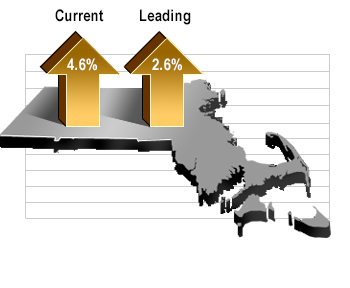Mass economy outpaces the nation in Q1, UMass journal reports
Reported employment & income growth may be overstated; Regional economy at full employment
April 2019
» Download the detailed report
 In the first quarter of 2019, Massachusetts real gross domestic product grew at a 4.6 percent annual rate according to MassBenchmarks, while U.S. real gross domestic product grew 3.2 percent according to the U.S. Bureau of Economic Analysis. Based on the latest information available, we now estimate that in the fourth quarter of 2018, the state's economy grew at a 2.3 percent annual rate of growth while the U.S. economy grew at a 2.2 percent rate according to the U.S. Bureau of Economic Analysis.
In the first quarter of 2019, Massachusetts real gross domestic product grew at a 4.6 percent annual rate according to MassBenchmarks, while U.S. real gross domestic product grew 3.2 percent according to the U.S. Bureau of Economic Analysis. Based on the latest information available, we now estimate that in the fourth quarter of 2018, the state's economy grew at a 2.3 percent annual rate of growth while the U.S. economy grew at a 2.2 percent rate according to the U.S. Bureau of Economic Analysis.
Economic growth in Massachusetts picked up in the first quarter led by surprisingly strong growth in employment and earnings. Payroll employment in Massachusetts grew at an estimated 2.3 percent rate in the first quarter compared to a U.S. rate of 1.7 percent. State wage and salary income grew at a torrid 17.4 percent annual rate in the first quarter, while U.S. wage and salary growth is expected to grow at a more modest 4.4 percent rate (the U.S. Bureau of Economic Analysis will release its official estimate for the U.S. on April 29th).
According to the U.S. Bureau of Labor Statistics, more jobs were added in Massachusetts in the first three months of this year than in the entirety of last year — employment grew by an estimated 24,100 in the first three months of 2019 as compared to an estimated 20,000 in 2018. Employment estimates for the last two quarters are based on a sample of employers and therefore may be subject to error. In the first nine months of 2018, job estimates are based on a census of employers and are more reliable. Since there is no apparent basis for an acceleration in job gains in the first quarter, it is very possible that actual job growth in the first quarter was not as strong as initial reports suggest.
Further, the strong Massachusetts earnings growth estimated for the first quarter is based on withholding tax revenues which can be volatile. First quarter estimates, in particular, can be influenced by the magnitude of bonuses earned for performance in the prior year. Accordingly, it is likely wage and salary income growth during the first quarter is smaller than that implied by the robust growth in withholding tax revenues, potentially much smaller.
"One thing is clear, the economy, especially in Massachusetts, is operating at or near full employment," noted Alan Clayton-Matthews, MassBenchmarks Senior Contributing Editor and Associate Professor of Economics and Public Policy at Northeastern University, who compiles and analyzes the Current and Leading Indexes. "The state's unemployment rate stood at 3.0 percent in March and is near the all-time low of 2.6 percent recorded at the height of the ‘Dot-Com' bubble in 2000,” he added. Statewide, initial unemployment claims are at all-time historical lows (the data go back to January 1973).
In March, the broader U-6 unemployment rate, which includes discouraged and marginally attached workers (including those working part-time involuntarily), stood at 6.5 percent in Massachusetts and 7.3 percent nationally. This is below pre-recession levels for both the state and the nation. About the only indication of slack in the state labor market is that there are still 25,000 more part-time workers in Massachusetts who would like to work full-time than prior to the Great Recession.
The only sign of weakness in the first quarter for the Massachusetts economy was in spending. Spending on items subject to the state regular sales and motor vehicle sales taxes declined at a 3.9 percent annual rate in the first quarter, following a strong fourth quarter when they grew at a 5.9 percent annual rate. In the first quarter, spending was 4.4 percent higher than in the first quarter of 2018.
State economic growth is expected to be modest through September. The MassBenchmarks Leading index is projecting a growth rate of 3.2 percent in the second quarter and 2.6 percent in the third quarter of 2019.
» Download the detailed report
April 26, 2019
---------
MassBenchmarks is published by the University of Massachusetts Donahue Institute in cooperation with the Federal Reserve Bank of Boston. The Donahue Institute is the public service, outreach, and economic development unit of the University of Massachusetts Office of the President. The Current and Leading Indexes are compiled and analyzed by Dr. Alan Clayton-Matthews, Associate Professor of Economics and Public Policy at Northeastern University and released quarterly by MassBenchmarks.

